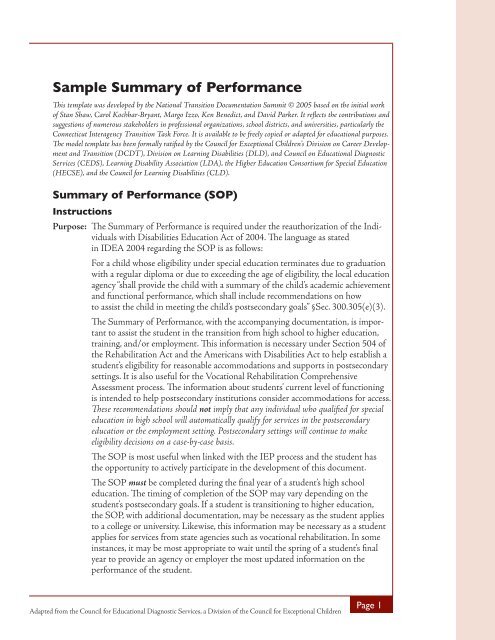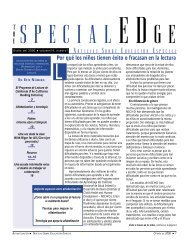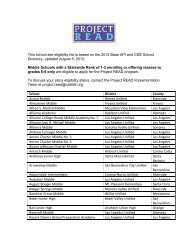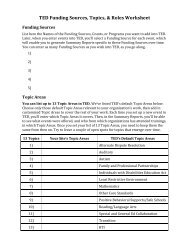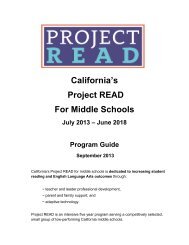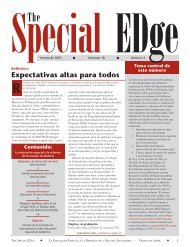A sample Summary of Performance template - CalSTAT
A sample Summary of Performance template - CalSTAT
A sample Summary of Performance template - CalSTAT
Create successful ePaper yourself
Turn your PDF publications into a flip-book with our unique Google optimized e-Paper software.
<strong>Summary</strong> <strong>of</strong> <strong>Performance</strong> TemplateSample <strong>Summary</strong> <strong>of</strong> <strong>Performance</strong>This <strong>template</strong> was developed by the National Transition Documentation Summit © 2005 based on the initial work<strong>of</strong> Stan Shaw, Carol Kochhar-Bryant, Margo Izzo, Ken Benedict, and David Parker. It reflects the contributions andsuggestions <strong>of</strong> numerous stakeholders in pr<strong>of</strong>essional organizations, school districts, and universities, particularly theConnecticut Interagency Transition Task Force. It is available to be freely copied or adapted for educational purposes.The model <strong>template</strong> has been formally ratified by the Council for Exceptional Children’s Division on Career Developmentand Transition (DCDT), Division on Learning Disabilities (DLD), and Council on Educational DiagnosticServices (CEDS), Learning Disability Association (LDA), the Higher Education Consortium for Special Education(HECSE), and the Council for Learning Disabilities (CLD).<strong>Summary</strong> <strong>of</strong> <strong>Performance</strong> (SOP)InstructionsPurpose: The <strong>Summary</strong> <strong>of</strong> <strong>Performance</strong> is required under the reauthorization <strong>of</strong> the Individualswith Disabilities Education Act <strong>of</strong> 2004. The language as statedin IDEA 2004 regarding the SOP is as follows:For a child whose eligibility under special education terminates due to graduationwith a regular diploma or due to exceeding the age <strong>of</strong> eligibility, the local educationagency “shall provide the child with a summary <strong>of</strong> the child’s academic achievementand functional performance, which shall include recommendations on howto assist the child in meeting the child’s postsecondary goals” §Sec. 300.305(e)(3).The <strong>Summary</strong> <strong>of</strong> <strong>Performance</strong>, with the accompanying documentation, is importantto assist the student in the transition from high school to higher education,training, and/or employment. This information is necessary under Section 504 <strong>of</strong>the Rehabilitation Act and the Americans with Disabilities Act to help establish astudent’s eligibility for reasonable accommodations and supports in postsecondarysettings. It is also useful for the Vocational Rehabilitation ComprehensiveAssessment process. The information about students’ current level <strong>of</strong> functioningis intended to help postsecondary institutions consider accommodations for access.These recommendations should not imply that any individual who qualified for specialeducation in high school will automatically qualify for services in the postsecondaryeducation or the employment setting. Postsecondary settings will continue to makeeligibility decisions on a case-by-case basis.The SOP is most useful when linked with the IEP process and the student hasthe opportunity to actively participate in the development <strong>of</strong> this document.The SOP must be completed during the final year <strong>of</strong> a student’s high schooleducation. The timing <strong>of</strong> completion <strong>of</strong> the SOP may vary depending on thestudent’s postsecondary goals. If a student is transitioning to higher education,the SOP, with additional documentation, may be necessary as the student appliesto a college or university. Likewise, this information may be necessary as a studentapplies for services from state agencies such as vocational rehabilitation. In someinstances, it may be most appropriate to wait until the spring <strong>of</strong> a student’s finalyear to provide an agency or employer the most updated information on theperformance <strong>of</strong> the student.Adapted from the Council for Educational Diagnostic Services, a Division <strong>of</strong> the Council for Exceptional ChildrenPage
<strong>Summary</strong> <strong>of</strong> <strong>Performance</strong> Template GPart 1: Background Information—Complete this section as specified. Please note: thissection also requests that you attach copies <strong>of</strong> the most recent formal and informalassessment reports that document the student’s disability or functional limitationsand provide information to assist in post-high school planning.Part 2: Student’s Postsecondary Goals—These goals should indicate the post-schoolenvironment(s) the student intends to transition to upon completion <strong>of</strong> high school.Part 3: <strong>Summary</strong> <strong>of</strong> <strong>Performance</strong>—This section includes three critical areas: Academic,Cognitive, and Functional levels <strong>of</strong> performance. Next to each specified area, pleasecomplete the student’s present level <strong>of</strong> performance and the accommodations,modifications, and assistive technology that were essential in high school to assist thestudent in achieving progress. Please leave blank any section that is not applicable.An accommodation is defined as a support or service that is provided to help astudent fully access the general education curriculum or subject matter. Students withimpaired spelling or handwriting skills, for example, may be accommodatedby a note-taker or permission to take class notes on a laptop computer. Anaccommodation does not change the content <strong>of</strong> what is being taught or theexpectation that the student meet a performance standard applied for all students.A modification is defined as a change to the general education curriculum or othermaterial being taught that alters the standards or expectations for students withdisabilities. Instruction can be modified so that the material is presented differentlyand/or the expectations <strong>of</strong> what the student will master are changed. Modificationsare not allowed in most postsecondary education environments. Assistive technologyis defined as any device that helps a student with a disability function in a given environment,but does not limit the device to expensive or “high-tech” options. Assistivetechnology can also include simple devices such as laminated pictures for communication,removable highlighter tapes, velcro, and other “low-tech” devices.The completion <strong>of</strong> this section may require input from a number <strong>of</strong> school personnel,including the special education teacher, regular education teacher, school psychologist,or related services personnel. It is recommended, however, that oneindividual from the IEP Team be responsible for gathering and organizing theinformation required on the SOP.Part 4: Recommendations to Assist the Student in Meeting Postsecondary Goals—Thissection should present suggestions for accommodations, adaptive devices, assistiveservices, compensatory strategies, and/or collateral support services to enhance accessin a post-high school environment, including higher education, training, employment,independent living, and/or community participation.Part 5: Student Input (Highly Recommended)—It is highly recommended that thissection be completed and that the student provide information related to this<strong>Summary</strong> <strong>of</strong> <strong>Performance</strong>. The student’s contribution can help (a) secondarypr<strong>of</strong>essionals complete the summary, (b) the student to better understand theimpact <strong>of</strong> his/her disability on academic and functional performance in thepostsecondary setting, (c) postsecondary personnel to more clearly understandthe student’s strengths and the impact <strong>of</strong> the disability on this student. Thissection may be filled out independently by the student or completed with thestudent through an interview.Page Adapted from the Council for Educational Diagnostic Services, a Division <strong>of</strong> the Council for Exceptional Children
<strong>Summary</strong> <strong>of</strong> <strong>Performance</strong> TemplateNationally ratified summary <strong>of</strong> performanceModel TemplatePart 1: Background InformationThis form was completed by: _ ________________________Title: _ _________Student name:__________________________________________________Date <strong>of</strong> birth: _ _____________ Year <strong>of</strong> graduation/exit: _ _________________Address:______________________________________________________(Street) (Town, state) (Zip code)Telephone number:_ _____________Current school: _________________Primary language:__________________City: ___________________________Student’s primary disability (diagnosis): _ ______________________________Student’s secondary disability (diagnosis), if applicable: _____________________When was the student’s disability (or disabilities) formally diagnosed? __________If English is not the student’s primary language, what services were provided for thisstudent as an English language learner?_ _______________________________Date <strong>of</strong> most recent IEP or most recent 504 plan: ________________________Date this summary was completed: ___________________________________Please check below and attach to this form the most recent copy <strong>of</strong> assessment reportsthat diagnose and clearly identify the student’s disability or functional limitations orthat will otherwise assist in postsecondary planning:r Psychological/cognitiver Neuropsychologicalr Medical/physicalr Achievement/academicsr Adaptive behaviorr Social/interpersonal skillsr Response to Intervention (RtI)r Language pr<strong>of</strong>iciency assessmentsr Reading assessmentsr Communicationr Behavioral analysisr Classroom observations (or in other settings)r Community-based assessment r Career/vocational or transition assessmentr Self-determinationr Assistive technologyr Informal assessment: _____________________________________r Informal assessment: _____________________________________r Other: _ ______________________________________________Adapted from the Council for Educational Diagnostic Services, a Division <strong>of</strong> the Council for Exceptional ChildrenPage
<strong>Summary</strong> <strong>of</strong> <strong>Performance</strong> TemplatePart 2: Student’s Postsecondary Goal(s)1.2.3.If employment is the primary goal, list the top three job interests:____________________________________________________________________________________________________________________________________________________________________________________Part 3: <strong>Summary</strong> <strong>of</strong> <strong>Performance</strong>(Complete all that are relevant to the student.)Academic Content AreaReading(basic reading/decoding,reading comprehension,reading speed)Math(calculation skills,algebraic problem solving,quantitative reasoning)Language(written expression,speaking, spelling)Learning skills(class participation, notetaking, keyboarding,organization, homeworkmanagement, timemanagement, study skills,test-taking skills)Present level <strong>of</strong>performance(grade level, standardscores, strengths, needs)Essential accommodations,modifications, and/or assistivetechnology utilized in high schooland why neededPage Adapted from the Council for Educational Diagnostic Services, a Division <strong>of</strong> the Council for Exceptional Children
<strong>Summary</strong> <strong>of</strong> <strong>Performance</strong> TemplatePart 3: <strong>Summary</strong> <strong>of</strong> <strong>Performance</strong> (continued)(Complete all that are relevant to the student)Cognitive AreasPresent level <strong>of</strong> performance(grade level, standard scores,strengths, needs)Essential accommodations,modifications, and/or assistivetechnology utilized in high schooland why neededGeneral ability and problem solving(reasoning/processing)Attention and executive functioning(energy level, sustained attention,memory functions, processing speed,impulse control, activity level)Communication(speech/language,assisted communication)Functional AreasSocial skills and behavior(interactions with teachers/peers,level <strong>of</strong> initiation in asking forassistance, responsiveness toservices and accommodations,degree <strong>of</strong> involvement in extracurricularactivities, confidenceand persistence as a learner)Independent living skills(self-care, leisure skills, personalsafety, transportation, banking,budgeting)Environmental access/mobility(assistive technology, mobility,transportation)Self-determination/self-advocacy skills(ability to identify and articulatepostsecondary goals, learningstrengths and needs)Career-vocational/transition/employment(career interests, career exploration,job training, employment experiencesand supports)Additional important considerationsthat can assist in making decisionsabout disability determination andneeded accommodations(e.g., medical problems, family concerns,sleep disturbances)Present level <strong>of</strong> performance(strengths and needs)Essential accommodations,modifications, and/or assistivetechnology utilized in high schooland why neededAdapted from the Council for Educational Diagnostic Services, a Division <strong>of</strong> the Council for Exceptional ChildrenPage
<strong>Summary</strong> <strong>of</strong> <strong>Performance</strong> TemplatePart 4:Recommendations to Assist the Student in Meeting Postsecondary GoalsSuggestions for accommodations, adaptive devices, assistive services, compensatory strategies,and/or collateral support services to enhance access in the following post-high school environments(only complete those relevant to the student’s postsecondary goals).Higher educationor career technical educationEmploymentIndependent livingCommunity participationPart 5: Student Input (Highly Recommended)<strong>Summary</strong> <strong>of</strong> <strong>Performance</strong>: Student PerspectiveA. How does your disability affect your schoolwork and school activities(such as grades, relationships, assignments, projects, communication,time on tests, mobility, extra-curricular activities)?B. In the past, what supports have been tried by teachers or by you to help you succeedin school (aids, adaptive equipment, physical accommodations, other services)?C. Which <strong>of</strong> these accommodations and supports has worked best for you?D. Which <strong>of</strong> these accommodations and supports have not worked?E. What strengths and needs should pr<strong>of</strong>essionals know about you as you enter thepostsecondary education or work environment?I have reviewed and agree with the content <strong>of</strong> this <strong>Summary</strong> <strong>of</strong> <strong>Performance</strong>.Student signature: _______________________________________ Date: _ _________Page Adapted from the Council for Educational Diagnostic Services, a Division <strong>of</strong> the Council for Exceptional Children


